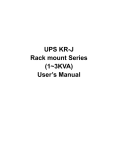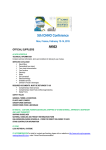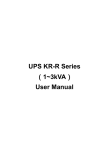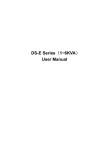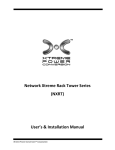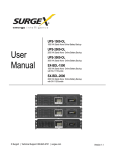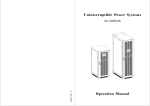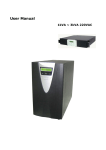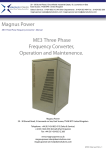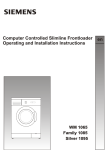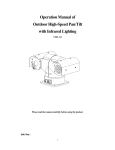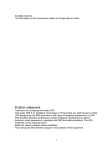Download UPS KR Series(1~3kVA) User`s Manual
Transcript
UPS KR Series(
(1~3kVA)
)
User’s Manual
【NOTE】
】
Please carefully read the user’s manual before operation for the sake of
understanding correct operation of the instrument. Please keep the manual
handy for future reference.
WARNING
The input and output of the instrument is with danger high
voltages which may endanger the safety of life. Please strictly
follow the operating description is not allowed to remove the
cover of the instrument.
1.
2.
3.
4.
5.
Please connect protective earth before power supply cables.
The input & output voltage of the UPS is dangerous which will endanger the safety.
Dangerous voltages are present inside the unit. Please do not open the cover of the UPS.
Please turn off the mains input switch and the battery switch for any urgency.
There are many kinds of power sources in the equipment, the line bank or the socket may still
have dangerous voltage even if the main power is disconnected.
6. Please remove the cable between the battery & UPS before repairing. It’s necessary to wait
for another 5 minutes for discharging, because of the dangerous voltages.
7. The wires should be fastened to the terminals. It is prohibited to short the anode and cathode
of battery. It’s prohibited to touch any two of wire connectors or bare end of connecting wires.
Otherwise, it may lead to damage of battery or personal injury.
8. Please keep the battery away from the fire and all the equipment that may cause spark to
prevent the danger and damage.
9. Please do not open or shatter the battery, the overflow electrolyte is with causticity that may
be harmful to life.
10. Please contact the professional personnel of the local dealer or the special maintenance
station for any trouble-shooting. Random disposal of the trouble is not allowed.
11. This is an A-grade product with electromagnetic compatibility.
12. This equipment must be installed and serviced by qualified personnel.
13. Before you replace the battery of different brand and different type, make sure the charging
voltage is matching with UPS charging voltage due to the different required charging voltage
of different battery, If any doubt, please consult with the manufacturer. Any changes of the
system configuration, structure and composition will influence the performance of UPS,
please consult with the manufacturer in prior before doing any changes.
14. Before usage, confirm that the temperature of the instrument has dropped into the normal run
range. It is recommended still placement for 24 hours in the normal temperature range before
startup.
Contents
1.Overview.............................................................................................................................................. 1
1.1 Profile........................................................................................................................................... 1
1.2 Performance Index ...................................................................................................................... 1
1.3 Primary Functions and Characteristics ....................................................................................... 2
1.4 Precautions .................................................................................................................................. 3
2 .Structure and Basic Principles ........................................................................................................... 5
2.1 General Structure ........................................................................................................................ 5
2.1.1 1KVA-3KVA Panel Indicator ............................................................................................... 5
2.1.2 1KVA Series Front Panel, Rear Panel Structure................................................................ 6
2.1.3 2KVA And 3KVA Front Panel, Rear Panel Structure .......................................................... 8
2.2 Basic Principles ......................................................................................................................... 10
2.3 Communication interface........................................................................................................... 10
3 .Equipment Installation ...................................................................................................................... 12
3.1 Site and Environment Requirements ........................................................................................ 12
3.1.1 Site Requirements............................................................................................................ 12
3.1.2 Environment Requirements ............................................................................................. 12
3.2 Procedures of Dismantling Cases ............................................................................................. 13
3.3 Installation of UPS ..................................................................................................................... 13
3.4 Selection of Cable ..................................................................................................................... 14
3.4.1 Selection of Input Circuit breaker ..................................................................................... 14
3.4.2 Selection of Input and Output Power Cord Diameter ...................................................... 14
3.5 Cable Connection ...................................................................................................................... 15
3.5.1 1KVA Series ..................................................................................................................... 15
3.5.2 2KVA & 3KVA Series ........................................................................................................ 16
3.5.3 Inspection of Electric Connection .................................................................................... 17
4 . Equipment Use and Maintenance ................................................................................................... 19
4.1 Preparations before First Start-up ............................................................................................. 19
4.2 UPS Start-up Sequence ............................................................................................................ 19
4.3 Daily Start-up and Shutdown ..................................................................................................... 19
4.4 Battery Daily Maintenance ........................................................................................................ 20
-i-
4.5 Battery Changing ....................................................................................................................... 21
4.6 Maintenance Guide ................................................................................................................... 21
4.6.1 Safety Precaution............................................................................................................. 22
4.6.2 Preventive and Regular Maintenance ............................................................................. 22
4.6.3 FAQ .................................................................................................................................. 23
4.7 Troubleshooting ......................................................................................................................... 24
4.7.1 Overview .......................................................................................................................... 24
4.7.2 Troubleshooting ............................................................................................................... 25
5 . Packing, Transportation and Storage .............................................................................................. 26
5.1 Packing ...................................................................................................................................... 26
5.2 Transportation............................................................................................................................ 26
5.3 Storage ...................................................................................................................................... 26
-ii-
1.Overview
1.1 Profile
1KVA, 2KVA, 3KVA UPS are high frequency, pure online and intellectualized UPS.
They are also ideal power guarantee for file server, enterprise server, central server,
microcomputer, concentrator, telecommunication system, data center, medical
facilities and those require high quality power protection. They can be widely used in
many key business areas such as post & telecom, finance, network, securities and
railway, etc.
1KVA, 2KVA, 3KVA UPS are single-phase alternating current input and output. Each
series has two products including standard time delay model and long time delay
model.
1.2 Performance Index
The main performance index of 1KVA/2KVA/3KVA Series is shown in Table 1-1.
Table 1-1 UPS Main Performance Index
Characteristic
Input
Index
Model
Rating voltage (V)
1KVA(L)
2KVA(L)
3KVA
3KVA(L)
50±10% / 60±10%(pre-set)
Input mode
Single-phase three-line
Battery voltage (V)
Voltage
2KVA
In range 160V~290V full load, 50% load even voltage low to 120V
Rating frequency (Hz)
Capacity
Output Characteristic
1KVA
(VA/W)
36
1000/700
(V)
Frequency
96
2000/1400
3000/2100
220±2%/230±2%/240±2% (pre-set)
(Hz)
50±0.2%/ 60±0.2% (Battery mode) (pre-set)
Waveform
Voltage
72
Sine wave
distortion
THD < 3% (Linear load)
factor
Power factor
0.7 (Lag)
Switching time (ms)
Overload capacity
0
105%~130% Load, lasting 60 seconds. 135%~150% Load, lasting 30 seconds.≥150%
lasting 300 milliseconds
Output mode
Sockets
Sockets and/or Terminal
-1-
UPS 1KVA~3KVA Series User’s Manual
Rational
Spare time
Rational
configuration
5 minutes
configuration
5 minutes
configuration
(PC LOAD)
for long time
(PC LOAD)
for long time
(PC LOAD)
for long time
delay
Charge recovery time
Other Characteristics
Rational
5 minutes
delay
delay
<12 hours (Standard time delay model)
Communication
RS232 interface supports UPS power management software or SNMP protocol
interface
Panel display
LED/LCD displays operation status of UPS
Warning function
Battery low voltage, abnormal power supply, UPS malfunction
Protection function
Battery low voltage protection, overload protection, short-circuit protection and excess
temperature protection
Frequency noise (dB)
< 45
Working temperature
0 ~ 40℃
Relative humidity
Size
0 ~ 95%, No condensation
(mm)
156×400×220
(W ×D×H)
Weight
(kg)
13
6.5
198×490×347
25
14
29
15
◆ Specifications are subject to change without prior notice.
1.3 Primary Functions and Characteristics
1. Intelligent RS232 communication function: With RS232 standard data
interface and UPS power management software, realize three remote-control
functions between computer and UPS, computer supervises UPS operation
and electric parameters, and realize long-distance power on/off function, as
well as supporting SNMP network adaptor (outlaid, connecting UPS through
RS232 interface), which enables UPS to directly become the new member of
network.
2. High input power factor: Adopt advanced active PFC technique, which
alleviates load on electric network and represents green power supply of new
generation.
3. High performance-price ratio: Adopts multiple power transfer and high
frequency PWM technique, high efficiency, small size and light weight as well
as improving operational reliability and reducing manufacturing cost, which
lowers the cost of the system design for customers.
4. Perfect protection function: Possess such functions as output low-voltage
protection, battery low-voltage protection, input low-voltage protection and
-2-
UPS 1KVA~3KVA Series User’s Manual
triple overflowing protection, etc and overcome previous defects such as high
frequency UPS' poor adaptability and weak resistance to shock for electric
network.
5. Low commercial power input voltage: Adopt independent quick detection
technique, even at the lower limit 120V of commercial power, the battery
remains off discharge, thus all energy output are taken from electric network,
ensuring the battery in the state with 100% energy storage, while at the same
time decreasing the battery discharge times and prolonging its life.
1.4 Precautions
Abide by the following general safety precaution during operation or maintenance.
1. Please don't remove the cover. This system can only be maintained or
repaired by professional maintenance personnel.
2. Protective ground terminals should be connected to earth end for sure.
3. High leakage danger! Connect to the ground before connecting UPS.
4. Install this UPS indoors with both temperature and humidity under control and
without dust.
5. The electric power of this UPS has multiple sources. Before maintaining, cut
the alternating current, exterior battery or interior battery's circuit breaker to
isolate the input energy.
6. Even if the AC power supply has been cut off, the danger from battery's high
voltage inside the UPS still exists.
7. If battery circuit has not been isolated from AC input, dangerous voltage may
possibly exists between battery terminal and ground terminal.
8. High voltage endangering personal safety exists in the storage battery of this
UPS. Please pay attention to insulation during installation and use.
9. Improper handling of acidic battery leads to leakage risk of chemistry
dangerous substance and corrosive liquid.
10. Dripping condensation should be happen if machine was operated under
low-temperature environment. So please install and use machine when
machine was full-dry, or there will has dangerous of electric shock.
-3-
UPS 1KVA~3KVA Series User’s Manual
Warning: Input and output voltage of this equipment is dangerous high voltage,
which can endanger personal life or safety. Please read carefully this Manual
during installation, operation and before use. Pay attention to various caution
nameplates and caution statements. Professional maintenance personnel
without proper authorization are not allowed to remove off the case cover of
this equipment.
-4-
2 .Structure and Basic Principles
2.1 General Structure
2.1.1 1KVA-3KVA Panel Indicator
BYPASS
①
③
②
LINE
④
INV
LOAD
100%
⑤
100%
⑥
FAULT
ON ⑦
POWER
OFF ⑧
BAT
Fig 2-1 1KVA~3KVA LED Panel Indicator
Illustration:
、BYPASS Indicator light
、Mains supply Indicator light
、INVERTER Indicator light
、Capacity indicator of load (contain four lights, each standing for 25% of
total capacity.)
、Capacity indicator of Battery Indicator light (contain four lights,
,each
standing for 25% of total capacity.)
、FAULT Indicator light
、“ON” Key (Please press “ON” key for 0.5 seconds to run the UPS.)
、“OFF” Key (Please press “OFF” key for 0.5 seconds to turn off
the UPS.)
)
Pressing "ON" key by 3s for battery test after turn on the UPS under AC
mode, pressing "ON" key by 3s for mute the buzzer after turn on under
battery mode.
-5-
UPS 1KVA~3KVA Series User’s Manual
①
LINE
⑥ ON
②
⑤
INVERTER
③
BYPASS
⑦ OFF
④
FAULT
⑧
Fig 2-2
1KVA~3KVA
SELECT
LCD Panel Indicator
Illustration:
、Mains supply Indicator light
②、INVERTER Indicator light
③、BYPASS Indicator light
④、FAULT Indicator light
⑤、LCD display screen
⑥、“ON” Key (Please press “ON” key for 0.5 seconds to run the
UPS.)
⑦、“OFF” Key (Please press “OFF” key for 0.5 seconds to turn off
the UPS.)
)
⑧ 、 "SELECT" Key (backlight or paging: The backlight will be
automatically turned off without any operation after 10s, and
will be back to output display page or fault page without any
operation after 30s. )
Pressing "ON" key by 3s for battery test after turn on the UPS under AC mode,
pressing "ON" key by 3s for mute the buzzer after turn on under battery mode,
pressing "SELECT" key by 3s for going back to history log or the previous page.
2.1.2 1KVA Series Front Panel, Rear Panel Structure
Front and rear panel structure of the main unit of 1KVA Series is illustrated in
Fig. 2-3.
-6-
UPS 1KVA~3KVA Series User’s Manual
BYPASS
LED Display
Screen
LIN E
INV
LOAD
LCD
Display
Screen
ON
100%
POWER
F AU LT
OFF
BAT
ON
LINE
I NVER TER
BYPASS
OFF
F AUL T
SELEC T
Holes for
air-in
LED Front Panel
SIGNA L
LCD Front Panel
RS232
RS232 &
DRY CONTACT
3
1
RS 232
AC OUTPUT
4.5A M ax.
2
USB
R S232
RS232 & USB
3
NetAgent Mini
SNMP
2
5
5
SNMP
These
communication
interfaces are
optional
AC OUTPUT
4.5A M ax.
A C INPUT
A C INPUT
1
4
4
FUSE 250V /10A
FUSE 250V /10A
Rear Panel
Rear Panel
3
1
3
1
RS232
RS232
A C OUTPUT
4.5A Max.
2
5
2
5
A C OUTPUT
4.5A Max.
AC INPUT
AC INPUT
4
4
FUS E 250V/10A
FUS E 250V/10A
Rear Panel
Rear Panel
3
1
RS232
AC OUTPUT
4.5A Max.
5
2
AC INPUT
4
FUS E 250V/10A
Rear Panel
Fig. 2-3 1KVA Series Front Panel and Rear Panel Structure
Rear Panel:
1.
Communication interface
2.
AC output sockets
3.
External battery connector (Optional)
4.
AC Input socket
5. Fan.
-7-
UPS 1KVA~3KVA Series User’s Manual
2.1.3 2KVA & 3KVA Front Panel, Rear Panel Structure
Front and rear panel structure of the main unit of 2KVA and 3KVA are illustrated
in Fig. 2-4. Inside which the switch on rear panel is composed of switch for
commercial power input and switch for storage battery. The upper switch is for
storage battery, and the lower one is for commercial power input.
BYPASS
LED Display
Screen
ON
LINE
LINE
INV
LOAD
100%
ON
POWER
FAULT
OFF
INVERTER
BYPASS
OFF
FAULT
BAT
SELECT
Holes for
air-in
Holes for
air-in
LED Front Panel
-8-
LCD Display
Screen
LCD Front Panel
UPS 1KVA~3KVA Series User’s Manual
1
2
1
2
BATTERY
OFF
ON
BATTERY
OFF
ON
6
POWER
POWER
RS232
6
RS232
8
3
AC INPUT
L
N
N
AC INPUT
PE
L
AC OUTPUT
4
8
DC
INPUT
AC INPUT
7
7
4
DC
INPUT
AC OUTPUT
16A Max.
5
AC OUTPUT
5
Rear Panel
1
2
Rear Panel
1
2
BATTERY
OFF
ON
6
POWER
BATTERY
OFF
ON
POWER
RS232
6
RS232
3
3
L
N
N
AC INPUT
PE
L
L
AC OUTPUT
N
N
AC INPUT
PE
L
AC OUTPUT
8
8
AC INPUT
AC INPUT
7
7
4
4
DC
INPUT
5
DC
INPUT
5
AC OUTPUT
AC OUTPUT
Rear Panel
1
2
Rear Panel
BATTERY
OFF
ON
6
POWER
RS232
SIGNAL
RS232
RS232 &
DRY CONTACT
3
L
N
N
AC INPUT
PE
L
AC OUTPUT
RS232
8
USB
RS232 & USB
SNMP
DC
INPUT
5
SNMP
7
4
NetAgent Mini
AC INPUT
AC OUTPUT
These
communication
interfaces are
optional
Rear Panel
Fig. 2-4 2KVA And 3KVA Front Panel and Rear Panel Structure
-9-
UPS 1KVA~3KVA Series User’s Manual
Rear Panel:
1.
Battery Breaker
2.
Input Breaker
3.
AC Input & AC Output terminal
4.
External battery connector (Optional)
5.
AC Output sockets
6.
Communication interface
7.
Fan
8.
AC input socket (optional).
2.2 Basic Principles
When commercial power is normal, UPS input, through PFC, increases the
voltage to ±360V stabilized DC voltage, which supplies DC/AC inverter and
transmits stable 220V AC, while at the same time completing the charging of
the battery. When commercial power is abnormal, the battery increases the
voltage through DC/DC to ± 360V DC voltage and supplies DC/AC inverter.
UPS principle lock diagram is shown in Fig. 2-5. DC/AC inverter adopts
half-bridge structure, while DC/DC voltage increase adopts push-pull or
BOOST circuit. PFC is active power-factor correction circuit controlled, while
CHARGER is complete isolation type charger.
220Vac
PFC AC/DC
DC/AC
SW
LOAD
DC/DC
CHARGE
BATTERY
Fig. 2-5 UPS Basic Principle Block Diagram
2.3 Communication interface
There are 4 kinds of communication interface for choosing (see Fig.2-6).
-10-
UPS 1KVA~3KVA Series User’s Manual
RS232
USB
RS232
RS232 & DRY CONTACT
SNMP
NetAgent Mini
RS232 & USB
SIGNAL
RS232
RS232
SNMP
Corresponding relations of pins for the communication interface of this series
UPS and those of general PC are shown in Table 2-3, Table 2-4.
Table 2-3 Corresponding relations of pins for the RS232 serial ports of this
series UPS and those of general PC:
Communication RS232 Interface for UPS
General RS232 Interface
9 (3)
2 (Receive)
6 (2)
3 (Deliver)
7 (5)
5 (Ground)
Table 2-4 Dry contact detail list:
Battery in normal
P1-P2 close, P2-P3 open
Utility in normal
P4-P5 close, P5-P6 open
UPS in normal
P7-P8 close, P8-P9 open
-11-
3 .Equipment Installation
3.1 Site and Environment Requirements
Before UPS installation, the site and environment of equipment room should
meet the essential conditions for safe and normal operation of equipment as
defined in this section. If the customer’s site conditions are not accord with the
minimum requirement of safe equipment operation, the customer should make
corresponding changes to the site conditions, and install the equipment only
after meeting the conditions of safe and normal equipment operation.
3.1.1 Site Requirements
The site conditions should accord with the essential conditions of safe and
normal equipment operation as stated in this section.
1.The equipment room must be equipped with applicable and effective fire
apparatus;
2.The commercial power, which supplies power for UPS, should be equipped
with dedicated circuit breaker or utility socket;
3.Strictly prohibit to store dangerous things, such as inflammable things,
explosive things in the equipment room;
4.Before equipment installation, the ground wire should be prepared. The
voltage of neutral wire and ground wire of commercial power cannot
exceed 5V;
5.The civil engineering construction of the equipment room should be
completed totally, and the floor should be sclerotic. The site must be tidy
and dry without dust.
3.1.2 Environment Requirements
Ambient temperature: 0℃~+40℃;
Relative humidity: 0%RH~95%RH, no condensation;
Cooling mode: air-cooling;
Verticality: no shock with orthogonal rake not exceeding 5º.
-12-
UPS 1KVA~3KVA Series User’s Manual
3.2 Procedures of Dismantling Cases
When installing the equipment, the packing should be removed after carrying
the equipment to the installation site. The packing of UPS equipment and
fittings (battery, etc.) should be wooden case and carton. Check the UPS
equipment and fittings against the shipping list.
If the equipment or fittings are damaged during transportation or the equipment
and fittings are not accord with the ordering contract, make site record in time
and immediately contact the local office or distributors.
3.3 Installation of UPS
Because the main unit size of 1KVA/2KVA/3KVA Series standard time-delay
model and long time-delay model is small, the UPS can be placed on the flat
surface directly without other fixing or installation. For convenient operation,
maintenance and heat emission of the equipment, there shall be at least
30cm~50cm room space reserved around the machine frame and 50cm above
the upper machine frame. The vent fan shall be installed beside the battery.
Keep good interior ventilation. The service life of the battery is the longest
when the battery is used under normal temperature (20℃). Recommend to
install air-conditioning equipment in equipment rooms with allowed conditions.
Refer to Fig. 3-1 for the precautions of UPS installation and use.
Fig. 3-1 Precautions of UPS Installation and Use
-13-
UPS 1KVA~3KVA Series User’s Manual
1.Place UPS on flat floor (avoid oblique and ragged floor).
2.Keep good ventilation, the distance of the back and side to the wall should
be above 30cm~50cm, to facilitate heat emission.
3.Avoid placing it in the location with sunshine, rain or dampness.
4.Never place it in the location with corrosive air.
5.Do not place articles on or around the UPS, to prevent the vent hole from
being blocked. No person is allowed to sit on it.
3.4 Selection of Cable
3.4.1 Selection of Input Circuit breaker
Before the input coil in of the equipment, install an circuit breaker or a
distribution box compliant with the power and capability of the equipment, to
isolate it with commercial power. Consider especially the charge power and the
current shock, the input circuit breaker can be higher than 1.5-2 times most
current of UPS input, which is without leakage current protection in order to
avoid error action. The distribution box should be better to be manufactured by
professional company. Please refer to Table 3-1.
Table 3-1 Recommended Sectional input circuit breaker
1KVA
2KVA
3KVA
Max.
Current
Recommended
Circuit breaker
Max.
Current
Recommended
Circuit breaker
Max.
Current
Recommended
Circuit breaker
(A)
(A)
(A)
(A)
(A)
(A)
AC
Input
6
10
12
20
18
32
DC
Input
26
50
26
32
30
50
3.4.2 Selection of Input and Output Power Cord Diameter
For the selection of conducting wire sectional area for UPS AC input and output
cable and battery cable, please refer to Table 3-2 for corresponding
recommended values, and choose values upwards.
-14-
UPS 1KVA~3KVA Series User’s Manual
Table 3-2
Recommended Sectional Flow of Cable Sectional Area of UPS
Sectional Area (mm2)
Ampacity
(A)
Rubber
(25°C)
1
1.5
2.5
4
6
10
16
25
8
12
20
28
42
70
96
125
6
9
15
20
30
50
64
100
Plastic
(25°C)
3.5 Cable Connection
To connect UPS cable only after confirming that all circuit breaker on UPS are
in disconnection condition, and the equipment is properly installed.
3.5.1 1KVA Series
All input and output connection methods of 1KVA series are shown in Fig. 3-2.
1.Take off
cover
DC INPUT
2.DC
Input
RS232
DC
Source
Socket output to load
!
Socket output to load
Share
alike
Socket output to load
AC OUTPUT
4.5A Max.
Commercial
power input
AC INPUT
FUSE 250V/10A
Fig. 3-2 1KVA Series connection Schematic
The AC input and output of 1KVA series only adopt the socket. Please insert
the power input wire in the commercial power socket directly, and insert the
load power cord into the output socket.
Note:
1. The power supply socket should be installed near UPS, and easy to touch.
-15-
UPS 1KVA~3KVA Series User’s Manual
2 .For long back-up UPS, battery connector is required to be connected. That is,
insert the battery connection wire plug of the battery box into the DC
connector on main unit rear panel. Refer to the relevant content of the
battery box installation and cable connection.
3. Battery connector is not allowed to be connected before AC power input.
3.5.2 2KVA & 3KVA Series
The input and output connection methods of 2KVA & 3KVA are shown in Fig.
3-3.
!
For long time-delay UPS,
connect to commercial
power first, switch on air
switch, then connect to
battery expansion line.
Terminal
output to load
BATTERY
OFF
ON
POWER
RS232
Commercial
power input
L
N
N
AC INPUT
.
PE
L
AC OUTPUT
AC INPUT
Fan
DC
Source
!
DC
INPUT
Socket output to load
Output socket
load sharing Socket output to load
AC OUTPUT
Fig.3-3 2KVA & 3KVA Series connection Schematic
AC input of 2KVA & 3KVA series adopts line bank, and the AC output adopts
socket and line bank. You can insert load power cord into the output socket
directly. Normally, the load current of each socket cannot exceed 10A.
1. When connecting the line bank, take the small cover board off from the line
bank, and pay attention to the definition of connection terminal: from the left
-16-
UPS 1KVA~3KVA Series User’s Manual
to the right (rear view) orderly are: live wire (L), neutral wire (N) and ground
wire (GND). After the connection, please check up whether the wire of
connection is correct and firm, and then install the small cover board back to
the box.
2. For long back-up UPS, battery connector is required to be connected. Refer to
the relevant content of the battery box installation and cable connection.
NOTE:
1.if choose IEC input socket, the terminal input connector will be
cancelled.
2. When the input and output connection are terminals, after the wiring
has been completed, tie the cables and fix them to the hooks which
are located below the bar line at the right corner to prevent loose.
3.5.3 Inspection of Electric Connection
1.Inspection of AC input wire: Whether the AC wire color spectrum is normative.
Whether the wire diameter of AC input cable is suitable. Whether control
switch is connected outside. Whether the connection of line wire (L), neutral
wire (N) and ground wire (PE) is correct. Whether the connection of AC input
wire is firm.
2.Inspection of AC output wire: Whether the AC output wire color spectrum is
normative. Whether the wire size of AC output cable is suitable. Whether
switch in the control switch outside. Whether the connection of line wire (L),
neutral wire (N) and ground wire (PE) is correct. Whether the connection of
AC output wire is firm.
Inspection of ground wire: Whether the ground wire of UPS is connected to
the ground line bank of the equipment room. Whether the connection of
ground wire is reliable.
The inspection of the voltage difference between neutral wire and ground wire:
the voltage difference should be less than 5Vac.
5.If the customer adopts the configuration of long time-delay model, examine
whether the battery cable connection of main unit box and battery box is
correct and reliable.
-17-
UPS 1KVA~3KVA Series User’s Manual
6.If the UPS is installed with remote monitoring equipment, examine whether the
connection of relevant RS232 serial port is correct.
7.Examine whether the wiring is in order, whether the cable binding accord with
the technical criterion.
8.Examine whether the installation and wiring are in favor of the future system
modification, expansion and maintenance.
-18-
4 . Equipment Use and Maintenance
4.1 Preparations before First Start-up
To ensure normal operation of UPS, please confirm the following before use:
1.Correct installation of input and output;
2.If the circuit breaker at the back of UPS is placed at “OFF”;
3.If the power end is connected to rated input power supply;
4.Confirm that UPS output does not short circuit, and the load capacity does
not exceed UPS capacity;
5.Confirm if computer or other instrument is turned off;
6.Confirm if battery voltage is normal;
7.It is not recommended to connect reactive load to the UPS output. Loads
are normally powered by electric network directly.
4.2 UPS Start-up Sequence
After confirming all the above, please start the machine by following means:
1.For 2KVA, 3KVA series, turn the circuit breaker at the back to “ON” position.
(Step 2 of direct operation of 1KVA series)
2.Press the "ON" button on the UPS panel to start UPS, the "INV" indicator
light will light up. After retardation time, the "BYPASS" light goes out and
the UPS is changed inversion power supply. By this time, the start-up is
completed and the equipment starts operation. Wait for about 20 seconds
after normal no-load operation to turn on the computer or other instrument.
Start the load in the sequence of high-power to low power, first start the
high-power equipment then in turns start equipment with lower power.
3.Start computer or other equipment.
4.3 Daily Start-up and Shutdown
During daily operation, operate as per the following for start-up or shut down:
-19-
UPS 1KVA~3KVA Series User’s Manual
1.Press the "ON" button on the UPS panel to start UPS, after 10 seconds, turn
on the computer or other instrument.
2.Before shutdown, turn off the computer and other instrument first and perform
no-load operation of UPS for 10 minutes. After the heat in the equipment has
been discharged, press the "OFF" button on the panel.
3.Normally, only when the UPS has been started and is working stably, can the
loading equipment power switch be turned on. First turn on high-power
equipment, then the equipment with lower power. Some equipment has
large start current (such as monitors of some brands). When starting such
equipment, overload protection (such as bypass operation) may occur. In
this case, it's recommended to start this type of equipment before other
equipment.
4.4 Battery Daily Maintenance
1.If the equipment has not been used for a long period, it should be charged for
more than ten hours.
2.Before operating the equipment, please charge it for ten hours after start-up.
The equipment can still be used during charging. If power failure occurs at
the same time, this discharge time may be under standard value.
3.Normally, battery will be charged and discharged every four to six months.
First discharge until shutdown then charge. The charging time for standard
device should be no less than ten hours each time.
4.At high temperature region, the battery should be charged and discharged
once every two months. The charging time for standard device should be
no less than ten hours each time.
5.Batteries of different capacity, type, and produced by different manufacturers
should not be mixed when using.
6.When cleaning battery case, only use wiping cloth and clear water, do not use
oil substance or organic solvent such as gasoline and thinner, etc.
-20-
UPS 1KVA~3KVA Series User’s Manual
7.Battery and battery unit should be kept away from ignition source as well as
all electrical equipment that may easily cause spark, to avoid causing
unnecessary loss.
8.During the use of battery unit equipped for UPS, regularly check if the charger
is in good condition to prevent the battery from being overcharged or
undercharged for a long time, and to avoid excessive discharge of battery.
After discharging, immediately (no later than 24 hours) perform complete
charging, only after then will the re-discharged be allowed. Never
re-discharge if the battery is not completely charged, otherwise it will cause
decrease in battery capacity or even damage to battery.
9.When not using UPS, please turn off the "OFF" switch on the panel to avoid
causing long-time battery discharge after commercial power failure. If the
UPS has not been used for a long time, regularly perform charging and
discharging of battery to avoid battery damage due to self-discharging.
4.5 Battery Changing
When changing storage battery, pay attention to the following:
1.Do not throw battery into fire to avoid explosion.
2.Do not open or disassemble battery as the electrolyte is harmful to skin and
eyes.
3.Properly recycle the battery according to relevant instructions thereon.
4.Replace the used battery with new ones that are of same type and grade.
5.Please consult the professional engineer to replace the battery.
6.Dangerous voltage may exist between battery terminal and the ground. Test
before touching.
4.6 Maintenance Guide
Proper
maintenance
includes
preventive
maintenance
and
remedial
maintenance, which is crucial to optimum operation of UPS and can ensure
relatively long service life of the equipment. Preventive maintenance includes
-21-
UPS 1KVA~3KVA Series User’s Manual
some procedures that are frequently performed. These procedures are used to
prevent system failure as well as to obtain best operating efficiency. Remedial
maintenance includes searching for system malfunction to facilitate effective
repair.
4.6.1 Safety Precaution
In order to securely and successfully conduct system maintenance, relevant
safety precautions must be observed and necessary tools and testing equipment
must be used, with the participation of qualified maintenance personnel. Pay
attention to the following safety operation rules:
1.Bear in mind that there is dangerous voltage in UPS even if the UPS system
is not in operation.
2.Make sure that the UPS operation and maintenance personnel are familiar
with this equipment and the content of this Manual.
3.When operating UPS, do not wear gold or silver jewelry such as ring or
watch, etc.
4.Do not take the safety operation procedure for granted. If there is any doubt,
consult personnel who are familiar with the equipment.
5.Be cautious that there is dangerous voltage in UPS. Before maintenance
and adjustment, use voltmeter to check and ensure that the power is
turned off and the equipment is under safe condition.
4.6.2 Preventive and Regular Maintenance
The following shows the preventive maintenance procedures which will improve
UPS system operation efficiency and reliability.
1.Keep the environment clean to avoid dust and chemical contamination to
the UPS.
2.Cable connection
Semiannually check the input and output cable connecting terminals once.
Carefully measure and check them to ensure good contact.
3.Check the working status of the vent fan on a regular basis to prevent
clogging of the air outlet. Repair it if there is any damage.
-22-
UPS 1KVA~3KVA Series User’s Manual
4.Perform periodic inspection on battery voltage and UPS working status.
4.6.3 FAQ
If the UPS fails to work properly after starting, please don't jump to the
conclusion of UPS failure. Please refer to the following and try to solve the
problem.
Problem 1
Power supply is normal; UPS is able to output AC 220V after start, yet in the
status of battery inversion with buzzer giving intermittent buzzing.
Possible cause: Unstable AC power input as a result of poor contact of the
junction points, sockets or other connection parts of the electric network feeder
circuit connected to the UPS.
Problem 2
After UPS is installed, and after the electric brake or UPS "ON" button is
switched on, the fuse will be burnt out or tripping occurs.
Cause: wrong connection of three UPS input wires, for example, zero line or fire
wire is connected to UPS earth wire (case); or wrong connection of three UPS
output wires.
Problem 3
After UPS is started, it outputs AC 220V, yet it's working under bypass status
("BYPASS" keeping lighted).
Possible cause: too-heavy load sustained by the device which exceeds rated
power of the UPS. In such cases, relieve the load to the UPS, or use a UPS of
higher rated power capacity. If it is a temporary bypass status caused by start-up
impact of the load, and returns to proper status automatically, that's normal
operation.
Problem 4
Display and output of the UPS are normal after start. However, the output stops
as soon as load is connected to it.
Cause:
(1)UPS severe overload or output circuit short circuit. Reduce the load to an
adequate amount, or check the cause for short circuit. In many cases, it is
caused by output adapter short circuit or input short-circuit fault owing to
-23-
UPS 1KVA~3KVA Series User’s Manual
equipment damage.
( 2 ) Failure to follow the load start-up sequence which shall begin with
heavy-duty equipment to low-duty ones. Restart UPS and wait till UPS runs
stably; first start heavy-duty equipment and then devices of lower duties.
Problem 5
UPS works properly after start-up, and automatically shuts off after a certain
period of time.
Cause: battery unit is not charged in time and is working under battery supply
status (not powered or not connected to power grid), thus resulting in battery
low-voltage protection of the UPS.
Warning: in the case of UPS battery low-voltage protection, please immediately
turn off all switches, and restart the UPS and charge the battery to full capacity
when power supply recovers. Long-period low-voltage of the battery will shorten
the service life of the battery.
Problem 6
After working for a certain period, with normal input display, the buzzer gives
intermittent buzzing and displays battery low-voltage simultaneously. Cause:
too-low power grid voltage makes the UPS work under battery feed status.
When the battery runs low and low-voltage occurs, it enters into protection
status.
Problem 7
UPS is started and working. When power supply breaks down, UPS fails to
output power.
Cause: the battery unit is not connected to main unit or is severely damaged.
4.7 Troubleshooting
4.7.1 Overview
In the case of device failure, first of all, find out any obvious damage and try to
determine what causes the failure: device problem or external environment
(such as temperature, humidity and load). Always check these external factors
before coming to the conclusion of UPS system damage.
-24-
UPS 1KVA~3KVA Series User’s Manual
4.7.2 Troubleshooting
Only some simple troubleshooting suggestions are provided here. If the
diagnosis result is not certain or the information given here is not sufficient for
problem-solving, please turn to your local office or distributor for repair.
1.Buzzer gives long buzzing, trouble light is on, UPS is powered through
bypass, and inverter fails.
Possible causes: (1) Output overload or short circuit results in UPS automatic
shutdown protection.
(2) Driving or power tube malfunction.
(3) Master control board failure.
(4) UPS Over-temperature protection
2.UPS works properly when power supply is OK, but it fails to function during
power failure.
Possible causes: (1) Battery failure.
(2) Battery charger malfunction: failing to charge battery
when power supply is OK.
(3) Poor contact between battery connecting wires or
connecting terminals.
3.Intermittent buzzing of the buzzer when UPS input is normal.
Possible causes: Abnormal input voltage that exceeds the UPS' allowable
input voltage range of power supply.
4.UPS works well when computer is in operation. After power failure, UPS
works properly and the computer breaks down.
Possible cause: Poor earth connection as a result of much too high floating
voltage of the zero line and earth wire.
5.All of panel indicator lamps are off.
Possible cause: Poor connection or malfunction of display control panel.
-25-
5 . Packing, Transportation and Storage
5.1 Packing
UPS main unit is packed in packing-paper carton. The interior volume of the
carton ( L × W × H) is: 625mm×320mm×465mm ( 2KVA , 3KVA ) and
510mm×275mm×345mm(1KVA). Pay attention to laying direction requirements
for each part when packing. The side faces of the carton are printed with such
direction marks as keep dry, handle with care, this end up, pile number limit, as
well as equipment model and other relevant information.
5.2 Transportation
Handle the goods with care; avoid violent impact. During transportation, place
the cartons in strict accordance with the laying direction indicated on the packing
carton to avoid damage to the devices.
5.3 Storage
The system equipment shall be stored in dry warehouse. Do not expose it to
insolation or rain. Place it in the way as shown on the packing boxes. Store it
where the ambient temperature is between - 25℃~+55℃ (except for battery). It
is recommended to store the standard device and battery at places with
temperature between 0~40℃ and relative humidity between 20%~80%. No
harmful gas, inflammable/detonable goods or corrosive chemicals shall be kept
in the warehouse which shall also be free from strong mechanical vibration,
impact and intense magnetic field affect. If not otherwise specified, the storage
period of the equipment under the required conditions of this clause is 6 months.
During long-term storage, charge the storage battery every 3 months.
-26-
4402-00527































